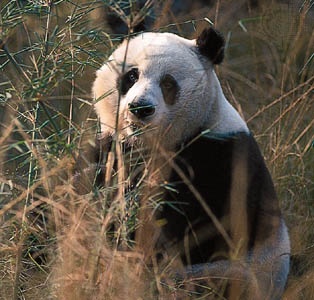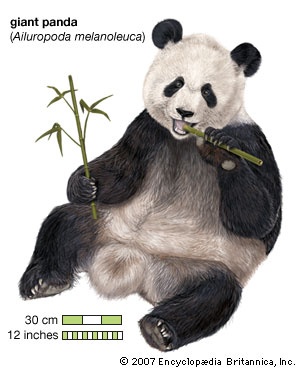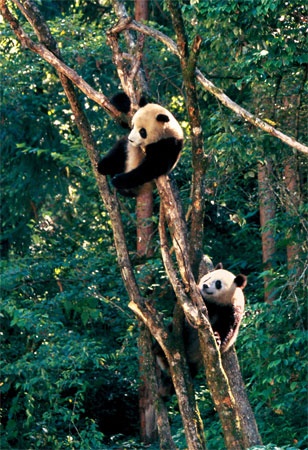panda, giant
mammal
Introduction
also called panda bear
 bearlike mammal inhabiting bamboo forests in the mountains of central China. Its striking coat of black and white, combined with a bulky body and round face, gives it a captivating appearance that has endeared it to people worldwide. Some 1,600 pandas are estimated to remain in the wild.
bearlike mammal inhabiting bamboo forests in the mountains of central China. Its striking coat of black and white, combined with a bulky body and round face, gives it a captivating appearance that has endeared it to people worldwide. Some 1,600 pandas are estimated to remain in the wild.
 Large males may attain 1.8 metres (6 feet) in length and weigh more than 100 kg (220 pounds); females are usually smaller. Round black ears and black eye patches stand out against a white face and neck. Black limbs, tail, legs, and shoulders contrast with the white torso. The rear paws point inward, which gives pandas a waddling gait. Pandas can easily stand on their hind legs and are commonly observed somersaulting, rolling, and dust-bathing. Although somewhat awkward as climbers, pandas readily ascend trees and, on the basis of their resemblance to bears, are probably capable of swimming. An unusual anatomic characteristic is an enlarged wrist bone that functions somewhat like a thumb, enabling pandas to handle food with considerable dexterity.
Large males may attain 1.8 metres (6 feet) in length and weigh more than 100 kg (220 pounds); females are usually smaller. Round black ears and black eye patches stand out against a white face and neck. Black limbs, tail, legs, and shoulders contrast with the white torso. The rear paws point inward, which gives pandas a waddling gait. Pandas can easily stand on their hind legs and are commonly observed somersaulting, rolling, and dust-bathing. Although somewhat awkward as climbers, pandas readily ascend trees and, on the basis of their resemblance to bears, are probably capable of swimming. An unusual anatomic characteristic is an enlarged wrist bone that functions somewhat like a thumb, enabling pandas to handle food with considerable dexterity.Natural history
As much as 90–98 percent of the panda's diet consists of the leaves, shoots, and stems of bamboo, a large grass available year-round in much of China's forested regions. Despite adaptations in the forepaws, teeth, and jaws for bamboo consumption, the giant panda has retained the digestive system of its carnivore ancestry and is therefore unable to digest cellulose, a main constituent of bamboo. Pandas solve this problem by rapidly passing prodigious quantities of the grass through their digestive tracts on a daily basis. As much as 16 out of every 24 hours is spent feeding, and elimination of wastes occurs up to 50 times per day. Fossilized dental remains indicate that the giant panda committed to bamboo as its principal food source at least three million years ago. Although unable to capture prey, pandas retain a taste for meat, which is used as bait to capture them for radio collaring and has made them pests in human camps on occasion. The species cannot naturally survive outside bamboo forests, though in captivity they have been maintained on cereals, milk, and garden fruits and vegetables. Bamboo is the healthier diet for captive pandas.
The giant panda's solitary nature is underscored by its reliance on its sense of smell (olfaction). Each animal confines its activities to a range of about 4 to 6 square km (1.5 to 2.3 square miles), but these home ranges often overlap substantially. Under this arrangement scent functions in regulating contact between individuals. A large scent gland located just below the tail and surrounding the anus is used to leave olfactory messages for other pandas. The gland is rubbed against trees, rocks, and clumps of grass, with scent conveying information on identity, sex, and possibly social status of the marking individual. Chemical analysis of marks is consistent with a difference in function for males and females. Males appear to use scent to identify the areas where they live, whereas females primarily use it for signaling estrus. Except for the mothers' care of infants, the only social activity of pandas takes place during females' estrus, which occurs annually during the spring and lasts one to three days. A spring mating season (March–May) and a fall birth season (August–September) are seen in both wild and captive populations. Males appear to locate females first by scent and ultimately by vocalizations. Assemblages of one to five males per female have been recorded. At this time males may become highly aggressive as they compete for the opportunity to mate.
Like bears, giant pandas undergo a delay in implantation of the fertilized ovum into the wall of the uterus, a period of two to three months after mating. Hormone levels in females' urine indicate that the period of embryonic/fetal growth and development lasts only about two months. Altogether, gestation averages 135 days (with a range of 90–184 days), but, because of the short growth phase, a term fetus weighs only about 112 grams (4 ounces) on average. Relative to the mother, giant pandas produce the smallest offspring of any placental mammal (about 1/800 of the mother's weight). For the first two to three weeks of life, the mother uses her forepaws and her thumblike wrist bones to cuddle and position the infant against herself in a rather uncarnivore-like and almost human fashion. Nearly half of the 133 captive births recorded before 1998 were of twins (twin), but panda mothers are typically unable to care for more than one infant. Reasons for the extremely small size of the offspring and the frequent production of twins are not understood, but both are traits shared with bears.
The newborn panda is blind and covered with only a thin all-white coat. It is virtually helpless, being able only to suckle and vocalize. It depends on its mother for warmth, nourishment, positioning at the breast, and stimulating the passage of wastes. Development is slow during the early months. Eyes begin to open at about 45 days, and the first wobbly steps are taken at 75–80 days. Its helpless state mandates birth in a den, an environment in which it lives for the first 100–120 days of life. By about 14 months, at which age the milk teeth have erupted, the infant readily consumes bamboo, and at 18–24 months weaning from the mother takes place. Separation from the mother must occur before a female can undertake the production of her next litter. Captive pandas may live beyond 30 years in captivity, but life span in the wild is estimated at about 20 years.
Conservation and classification

 Fossils from northern Myanmar and Vietnam and much of China as far north as Beijing indicate that the giant panda was widely distributed throughout eastern Asia during the early Pleistocene Epoch (1,800,000 to 10,000 years ago). Human destruction of its forest habitat, combined with poaching, has restricted the species to remote fragments of mountain habitat along the eastern edge of the Tibetan Plateau (Tibet, Plateau of) in the Chinese provinces of Sichuan (Szechwan) (Sichuan), Shaanxi (Shensi) (Shensi), and Gansu (Kansu) (Gansu). The total area of these habitats is about 13,000 square km (5,000 square miles), and in recent times periodic mass flowering and die-offs of bamboo have brought starvation for some populations. (Five to 10 years are required for bamboo forests to recover from these natural events.) Since the 1990s China has greatly expanded its conservation efforts, and it now regards this endangered species as a national treasure. The reserve system has been expanded from 14 sites to more than 40, and cooperative international arrangements were implemented to provide training in reserve management and captive breeding (animal breeding). Prior eras of giving pandas as gifts and of short-term commercial loans to zoos have given way to lending agreements that generate funds for preservation of the wild population. More than 120 pandas are maintained in captivity in China, and another 15 to 20 are found in zoos elsewhere. Captive populations are increasing. Su-Lin, the first of the giant pandas to be exhibited in the West, reached the United States as an infant in 1936 and was a popular attraction at the Brookfield Zoo, near Chicago, until its death in 1938. No European observed a live giant panda in the wild until the Walter Stötzner expedition of 1913–15, although Armand David, a Jesuit missionary, discovered some panda furs in 1869.
Fossils from northern Myanmar and Vietnam and much of China as far north as Beijing indicate that the giant panda was widely distributed throughout eastern Asia during the early Pleistocene Epoch (1,800,000 to 10,000 years ago). Human destruction of its forest habitat, combined with poaching, has restricted the species to remote fragments of mountain habitat along the eastern edge of the Tibetan Plateau (Tibet, Plateau of) in the Chinese provinces of Sichuan (Szechwan) (Sichuan), Shaanxi (Shensi) (Shensi), and Gansu (Kansu) (Gansu). The total area of these habitats is about 13,000 square km (5,000 square miles), and in recent times periodic mass flowering and die-offs of bamboo have brought starvation for some populations. (Five to 10 years are required for bamboo forests to recover from these natural events.) Since the 1990s China has greatly expanded its conservation efforts, and it now regards this endangered species as a national treasure. The reserve system has been expanded from 14 sites to more than 40, and cooperative international arrangements were implemented to provide training in reserve management and captive breeding (animal breeding). Prior eras of giving pandas as gifts and of short-term commercial loans to zoos have given way to lending agreements that generate funds for preservation of the wild population. More than 120 pandas are maintained in captivity in China, and another 15 to 20 are found in zoos elsewhere. Captive populations are increasing. Su-Lin, the first of the giant pandas to be exhibited in the West, reached the United States as an infant in 1936 and was a popular attraction at the Brookfield Zoo, near Chicago, until its death in 1938. No European observed a live giant panda in the wild until the Walter Stötzner expedition of 1913–15, although Armand David, a Jesuit missionary, discovered some panda furs in 1869.The classification of giant pandas has long been a subject of controversy. Anatomic, behavioral, and biochemical data have been used to place pandas with bears (family Ursidae), with raccoons (Procyonidae), or in a family of their own (Ailuridae). Improved molecular analyses made during the 1990s strongly suggest bears as the giant panda's closest relatives, and many of their behavioral and reproductive characteristics are consistent with this placement.
Additional Reading
George B. Schaller et al., The Giant Pandas of Wolong (1985), written with the help of Chinese researchers, is the first account of panda biology and continues to be the single most comprehensive source of information on the species.Secrets of the Wild Panda (1994), produced for the National Geographic Society by Mark Stauffer, Adrian Warren, and Nicholas Noxon, is a video documentary of pandas in their natural habitat along with the biologists who are studying them to ensure their survival.
- Barbey d'Aurevilly, Jules-Amédée
- Barbican
- Barbie
- Barbie, Klaus
- Barbier, Antoine-Alexandre
- Barbirolli, Sir John
- barbiturate
- barbituric acid
- Barbizon school
- Barbon, Nicholas
- Barbon, Praise-God
- barbooth
- Barbosa, Jorge
- Barbotine ware
- Barbour, John
- Barbour, Philip P
- Barbourville
- Barbra Streisand
- Barbusse, Henri
- Barbé-Marbois, François, marquis de
- barcarole
- Barcelo, Gertrudis
- Barcelona
- Barcelona, Archaeological Museum of
- Barcelona chair